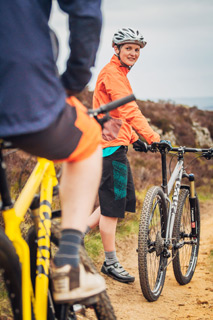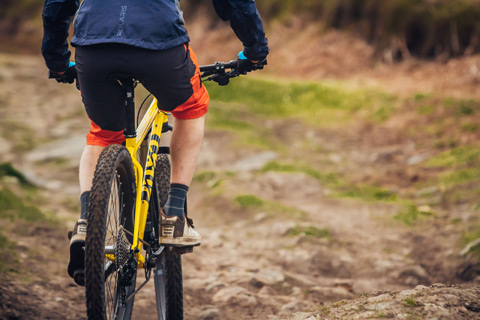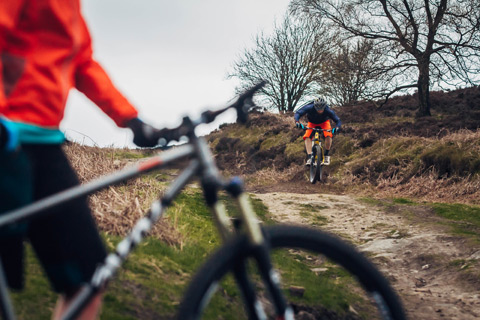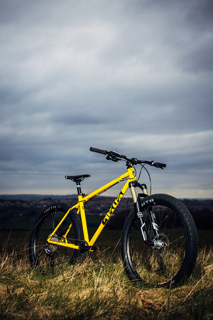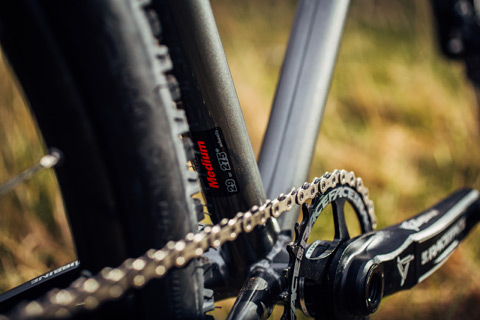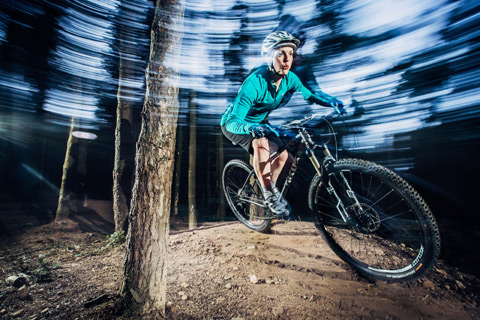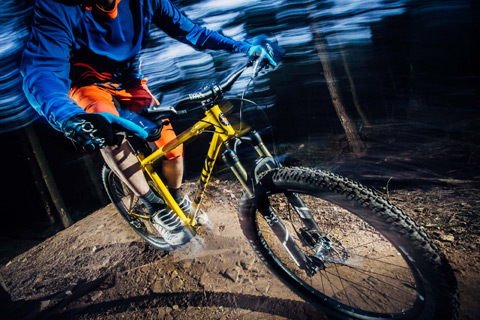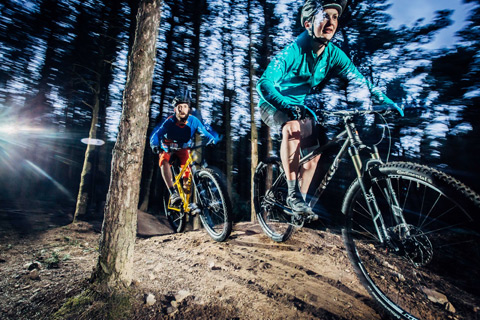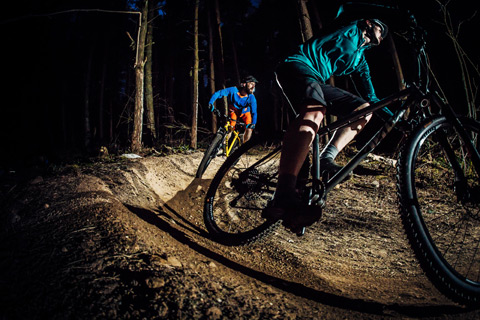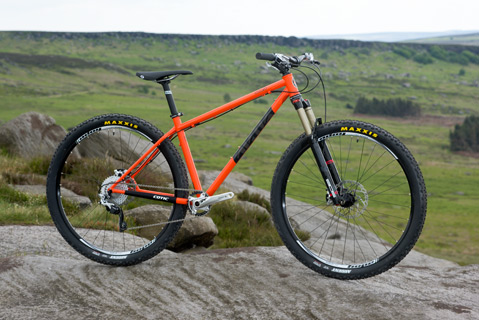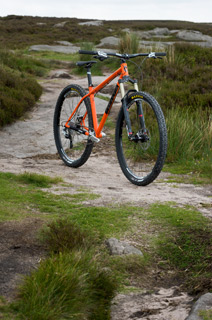Availability
0% Finance - UK ONLY
NO LONGER IN PRODUCTION

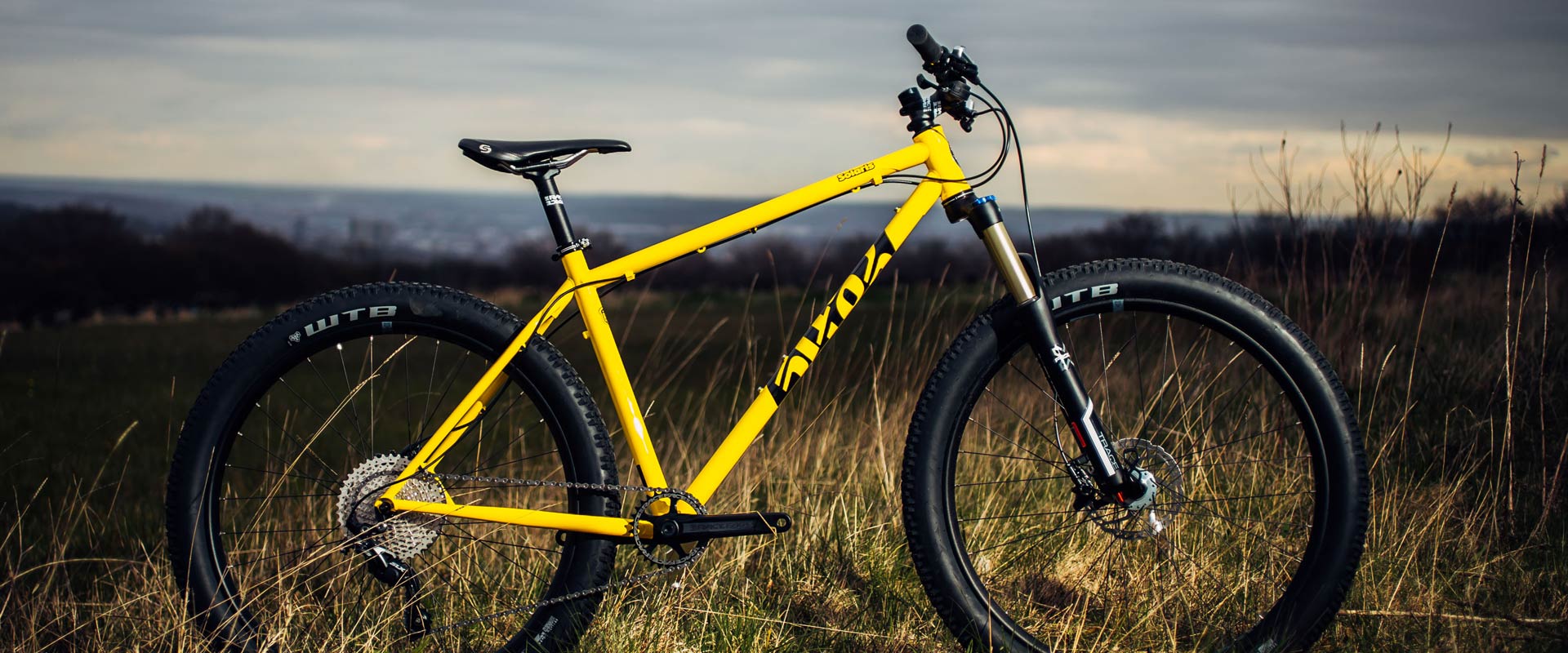
The Solaris is our flagship big wheel hardtail: 29er or 27.5+
Have you seen the new SolarisMAX? Click here now to learn more.
Our fastest hardtail just got faster: The latest thinking on bike fit and progressive handling with OFI geometry, sprinkle some 27.5+ sized tyre compatibility and you have super fast, future proofed fun machine that has to be experienced to be believed.
Handling is confidence inspiring, interactive and fun. Planted feel at high speeds on the rocks, and carve-it-up traction in the corners.
As always, Reynolds 853 front triangle is all present and correct. Our signature features such as Ovalform top tube and 35mm seat tube keep the weight, stiffness and durability in the sweet spot. Grace, durability, clean lines, great attention to detail.
All of this adds up to give the Solaris amazing adaptability; from sus forked, big barred trail warrior, to Plus tyred, high traction monster truck, across to rigid forked, map crossing smoothie and everything in between. Where will your Solaris take you?.......
29inch wheels roll easy and give a lot of stability and confidence in rougher terrain, at the expense of being a little heavier than regular 27.5" wheels. They can suit taller riders better as the way the frame is packaged around the larger wheels (longer rear end, longer wheelbase, taller front end) suit the proportions of a taller rider better and minimise any potential drawbacks.
The 275 Plus option brings a wide, supportive rim in the same size as 27.5" wheels, with a wide (up to 2.8" on the Solaris) high volume tyre which ends up the about the same diameter as a regular 29er wheel. This setup is a little heavier than 29" wheels, but you run the large volume tyres at very low pressure (typically around 12-16psi) which gives loads of grip and traction, a lot of comfort. It smooths off the edges of rocky downhills, and allows incredible rock crawling traction on technical climbs. The aren't at their best when being heavily loaded into berms and more groomed trail features at speed, so choose the wheel type that will suit you best. We're happy to help with this, just call or drop us an email.
- Large diameter, thinwall, air hardening Reynolds 853 steel front triangle with signature Ovalform top tube
- 44mm standard head tube designed with external bottom cup for taper steerer compatiblity and zero stack top cup for minimal stack height
- Oversized 35mm seat tube gives great precision to the ride
- 31.6mm seatpost size is dropper seatpost compatible (external remote only) and the frame has hose clips for the remote under the top tube
- Signature Cotic 4130 cromo wishbone stay rear end. Bridge-less S-bend chainstays with Cotic Hexten gussets for improved fatigue life
- Clearance for 29 or 27.5+ - 29x2.4 or 27.5x2.8
- Geometry with commitment! Minimum 100mm travel forks or 490mm rigid. Strong enough for up to 120mm forks
- Cotic OFI geomtry uses long top tube, slack seat angle layout for inline seatposts and short stem set up (50-80mm stems recommended) and maintains good weight distribution for great handling
- Sizes - 17.5", 19" and 20.5". The frames are designed to be compact and chuckable.
- Weight - 4.9lbs for the 19"
NO LONGER IN PRODUCTION
The chart is a guide to frame size. The Solaris features Optimised For Inline geometry.
Our original Solaris geometry was designed around a 80mm travel suspension/470mm rigid fork as a minimum with 44-46mm offset. The original geometry also assumed a layback seatpost. Running forks longer than this (most people used minimum 100mm forks on their Solaris) which shortens the reach (distance from bars to BB) and running an inline or dropper post (which are usually inline clamp) shortens the position from the other end of the bike, squeezing the room available to the rider.
Optimised For Inline on the new Solaris takes the rider position and BB height we originally intended for 100mm forks but maintains it with 120mm forks installed and an inline seatpost, which maintains rider position better for both fork travels now that the 80mm option doesn't need to be accounted for. We also slackened the head angle to allow for the emergence of 51mm offset forks. You can happily use either offset (46- or 51).
If you would like us to help you out with sizing, or are on the cusp of two sizes then drop us a line at size@cotic.co.uk or give us a call on 07970 853531 and we'll be happy to discuss set up based on what you're riding at the moment.
120mm travel forks
Frame Size
Medium
Large
XL
Seat Tube (centre-top)
440mm
480mm
520mm
Top Tube Length (Effective)
614mm
631mm
657mm
Head Angle
68°
68°
68°
Seat Angle
72.5°
72.5°
72.5°
Chainstay Length
442mm
442mm
442mm
Wheelbase
1141.2mm
1162.2mm
1180.7mm
BB Drop
52mm
52mm
52mm
Head Tube Length
100mm
110mm
120mm
Reach
425.7mm
436.8mm
457.8mm
Stack
600.3mm
609.6mm
618.9mm
Usual Height Range
174cm - 182cm
182cm - 191cm
188cm - 196cm
Stem Length
40-80mm
40-80mm
40-80mm
All measurements are based on 120mm travel fork with 20% sag (i.e. rider on board)
4 ¾" travel forks
Frame Size
Medium
Large
XL
Seat Tube (centre-top)
17.5"
19"
20.5"
Top Tube Length (Effective)
24.2"
24.8"
25.7"
Head Angle
68°
68°
68°
Seat Angle
72.5°
72.5°
72.5°
Chainstay Length
17.4"
17.4"
17.4"
Wheelbase
44.9"
45.7"
46.5"
BB Drop
2.05"
2.05"
2.05"
Head Tube Length
3.9"
4.3"
4.7"
Reach
16.7"
17.2"
18.0"
Stack
23.6"
24.0"
24.3"
Usual Height Range
5'9" - 6'0"
6'0" - 6'3"
6'2" - 6'5"
Stem Length
40-80mm
40-80mm
40-80mm
All measurements are based on 120mm travel fork with 20% sag (i.e. rider on board)
100mm travel forks
Frame Size
Medium
Large
XL
Seat Tube (centre-top)
440mm
480mm
520mm
Top Tube Length (Effective)
614mm
631mm
657mm
Head Angle
68.5°
68.5°
68.5°
Seat Angle
73°
73°
73°
Chainstay Length
442mm
442mm
442mm
Wheelbase
1136.4mm
1151.2mm
1176.0mm
BB Drop
56mm
56mm
56mm
Head Tube Length
100mm
110mm
120mm
Reach
432.1mm
443.2mm
464.2mm
Stack
595.8mm
605.0mm
614.1mm
Usual Height Range
174cm - 182cm
182cm - 191cm
188cm - 196cm
Stem Length
40-80mm
40-80mm
40-80mm
All measurements are based on 100mm travel fork with 20% sag (i.e. rider on board)
4 " travel forks
Frame Size
Medium
Large
XL
Seat Tube (centre-top)
17.5"
19"
20.5"
Top Tube Length (Effective)
24.2"
24.8"
25.7"
Head Angle
68.5°
68.5°
68.5°
Seat Angle
73°
73°
73°
Chainstay Length
17.4"
17.4"
17.4"
Wheelbase
44.7"
45.3"
46.3"
BB Drop
2.25"
2.25"
2.25"
Head Tube Length
3.9"
4.3"
4.7"
Reach
17.0"
17.5"
18.3"
Stack
23.4"
23.8"
24.2"
Usual Height Range
5'9" - 6'0"
6'0" - 6'3"
6'2" - 6'5"
Stem Length
40-80mm
40-80mm
40-80mm
All measurements are based on 100mm travel fork with 20% sag (i.e. rider on board)
Seatpost diameter: 31.6mm (wise to get a decent length one)
Front Mech: 34.9mm band on, Conventional Top Pull or Side Swing
Bottom Bracket width: 73mm
Bottom Bracket thread: Conventional English/BSA
Headset: 44mm cup (for example a Hope 2H)[click here for info]
Rear Hub: Normal 135 x 10 QR
Dropper Post: External Only - Dedicated remote routing under top tube
Complete Headsets 44mm HeadtubeCane Creek Headset 40 Series ZS44/EC44 £45 Hope 2H for tapered steerer (black) £105 Hope 2H for tapered steerer (orange) £105 Hope 2H for tapered steerer (blue) £105 Hope 2H for tapered steerer (red) £105 Hope 2H for tapered steerer (purple) £105 Hope 2H for tapered steerer (silver) £105 Hope 2H for tapered steerer (smoke) £105 Enduro Bearings Stainless Steel Maxhit Headset £140
(headset and bottom bracket prices include fitting)
July 2015: Solaris 2 Development
To start the development of the latest Solaris, we were responding to some changes in the way people set up their bikes.
Firstly, no one was using 80mm forks and very few 470mm rigids, and the original frame was designed to use these as a minimum. At the other end of the scale more and more people were using 120mm forks, but this was on the limit of the geometry and did present a bit of a compromise for all round riding.
Secondly, we had successfully developed the small size Solaris which diverged from the original geometry particularly with respect to head angle. As we were limited in terms of how short we could make the frame because of the wheels, we had to accept that shorter riders would use 50mm or even 40mm stems to get a good position, so we slackened the head angle to slow the steering down a little to balance this out. Fast forward 3 years and now most people are looking to run stems down to that kind of length regardless of how tall they are.
Both of these things put pressure on cockpit room. People want shorter stems, but when used with longer forks, the reach of the frame is reduced. Ally this to the widespread adoption of dropper seatposts which usually use an inline clamp and we felt we needed to re-optimise the frame for these kinds of things.
The great thing for this project is that we had applied solutions to all these problems when we developed the OFI geometry on the 27.5 wheel bikes, so it was a matter of applying those ideas for the new bike.
Firstly, OFI dictates that we optimise the reach for the longer fork (in this case 120mm travel) so the reach was reset to the design length we established for the original frame on 80mm travel forks, but with longer forks installed. Secondly, we tweaked the seat angle so it was in a good position for inline seatposts and saddle in the middle of the rails for 120mm forks, so it would still be possible to achieve a good position with 100mm forks but the 120mm setting wouldn’t be too far rearward.
The final piece of the puzzle was establishing the new handling layout. Fork offsets have increased for 29er bikes. The 51mm offset that was the sole provision of the Trek Group was made available across the market 3 years ago. The original frame was designed at a time when 44mm offset was the largest available and some 29er forks were still around the 40mm mark, same as 26”. This resulted in a steepening of the head angle compared to the smaller wheel bikes to compensate. Larger fork offset reduces trail and lightens the steering.
Having been instrumental in the development of the small frame with the slacker head angle, Paul was convinced this could work for the larger sizes, having tested the small bike with 51mm offset forks from X Fusion (all X Fusion 29er forks are 51mm offset). We have a series of anglesets for the 44mm head tube our bikes use for exactly these kind of situations, so Cy tried out the 1 deg (net effect 0.7deg slacker head angle, 3mm lower BB) and 1.5 deg options (net effect 1deg slacker head angle, 5mm lower BB) in his large Solaris with 120mm travel Magura TS-8 forks. These have a 46mm offset so would also show whether slackening the angles would have an adverse effect on the forks with a smaller offset. After some back to back testing we found that not only did all the people who tried it prefer the slacker option, it was also faster around our test loop. The geometry was measured and set from this layout, with the OFI rider fit principles applied to bring us to the final layout. Because you can use a short stem and wide bars without compromising the fit on the bike, it still has a lightness of touch in the singletrack which you might find surprising just looking at the numbers. It works better with 120mm forks than the previous bike and is much more at home on rough, high speed terrain. By tightening the window of operation to 100-120mm forks, it works better in both guises than the previous bike.
So the geometry of the new frame was set, but there was one last spanner to get (potentially) thrown in the works: Plus sized wheels. We had looked into 29+ when that came about, but it involved some bespoke parts and compromises we weren’t comfortable with. It also become clear that no suspension fork manufacturers (at the time) were going to support it, and that was a no-go for us. We like our suspension forks, and not having them would have made the Solaris into something quite different. However, 27.5+ started to gain some popularity and once the lovely chaps at WTB had sent us the specs we knew it would fit in the Solaris so we had to test it.
We got the wheels earlier in 2015 and were immediately impressed with them. The weight was good, the rolling resistance surprisingly low, and the performance and grip both over the rocks and also in fast singletrack was impressive. That they proved faster than Ardent 29er wheels over our woodsy singletrack loop was something we just weren’t expecting. You can read our blogs about the chubby tyres here:
cotic.co.uk/news/2015/chubbyupdate2
Given that we had tweaked the new Solaris to have slightly more clearance out back, it was a no brainer to offer 275Plus as an option on the bike. The main conclusion from our testing (apart from how much we liked them) was that a lighter narrower rear rim was definitely preferable to the much heavier wider option, but on the front we much preferred the support of the wider rim to prevent deformation when loading the front of the bike in corners. We compared a WTB KOM i25 (25mm internal) at 445grms to a WTB Scraper i45 (45mm internal) at 695grms as the extremes. For production we’re going with WTB’s Asym i29 rear at 510grms and the Asym i35 front at 560gms. This will give us the support we like on the front with the snappy feel at the bike with the support for the tyre we like. They are available as a chassis pack option or as an upgrade on the complete bike from August 2015
Read about the development of the original Solaris...
0% Finance - UK ONLY
NO LONGER IN PRODUCTION


The Solaris is our flagship big wheel hardtail: 29er or 27.5+
The Solaris is our flagship big wheel hardtail: 29er or 27.5+
Have you seen the new SolarisMAX? Click here now to learn more.
Our fastest hardtail just got faster: The latest thinking on bike fit and progressive handling with OFI geometry, sprinkle some 27.5+ sized tyre compatibility and you have super fast, future proofed fun machine that has to be experienced to be believed.
Handling is confidence inspiring, interactive and fun. Planted feel at high speeds on the rocks, and carve-it-up traction in the corners.
As always, Reynolds 853 front triangle is all present and correct. Our signature features such as Ovalform top tube and 35mm seat tube keep the weight, stiffness and durability in the sweet spot. Grace, durability, clean lines, great attention to detail.
All of this adds up to give the Solaris amazing adaptability; from sus forked, big barred trail warrior, to Plus tyred, high traction monster truck, across to rigid forked, map crossing smoothie and everything in between. Where will your Solaris take you?.......
29inch wheels roll easy and give a lot of stability and confidence in rougher terrain, at the expense of being a little heavier than regular 27.5" wheels. They can suit taller riders better as the way the frame is packaged around the larger wheels (longer rear end, longer wheelbase, taller front end) suit the proportions of a taller rider better and minimise any potential drawbacks.
The 275 Plus option brings a wide, supportive rim in the same size as 27.5" wheels, with a wide (up to 2.8" on the Solaris) high volume tyre which ends up the about the same diameter as a regular 29er wheel. This setup is a little heavier than 29" wheels, but you run the large volume tyres at very low pressure (typically around 12-16psi) which gives loads of grip and traction, a lot of comfort. It smooths off the edges of rocky downhills, and allows incredible rock crawling traction on technical climbs. The aren't at their best when being heavily loaded into berms and more groomed trail features at speed, so choose the wheel type that will suit you best. We're happy to help with this, just call or drop us an email.
- Large diameter, thinwall, air hardening Reynolds 853 steel front triangle with signature Ovalform top tube
- 44mm standard head tube designed with external bottom cup for taper steerer compatiblity and zero stack top cup for minimal stack height
- Oversized 35mm seat tube gives great precision to the ride
- 31.6mm seatpost size is dropper seatpost compatible (external remote only) and the frame has hose clips for the remote under the top tube
- Signature Cotic 4130 cromo wishbone stay rear end. Bridge-less S-bend chainstays with Cotic Hexten gussets for improved fatigue life
- Clearance for 29 or 27.5+ - 29x2.4 or 27.5x2.8
- Geometry with commitment! Minimum 100mm travel forks or 490mm rigid. Strong enough for up to 120mm forks
- Cotic OFI geomtry uses long top tube, slack seat angle layout for inline seatposts and short stem set up (50-80mm stems recommended) and maintains good weight distribution for great handling
- Sizes - 17.5", 19" and 20.5". The frames are designed to be compact and chuckable.
- Weight - 4.9lbs for the 19"
NO LONGER IN PRODUCTION
The chart is a guide to frame size. The Solaris features Optimised For Inline geometry.
Our original Solaris geometry was designed around a 80mm travel suspension/470mm rigid fork as a minimum with 44-46mm offset. The original geometry also assumed a layback seatpost. Running forks longer than this (most people used minimum 100mm forks on their Solaris) which shortens the reach (distance from bars to BB) and running an inline or dropper post (which are usually inline clamp) shortens the position from the other end of the bike, squeezing the room available to the rider.
Optimised For Inline on the new Solaris takes the rider position and BB height we originally intended for 100mm forks but maintains it with 120mm forks installed and an inline seatpost, which maintains rider position better for both fork travels now that the 80mm option doesn't need to be accounted for. We also slackened the head angle to allow for the emergence of 51mm offset forks. You can happily use either offset (46- or 51).
If you would like us to help you out with sizing, or are on the cusp of two sizes then drop us a line at size@cotic.co.uk or give us a call on 07970 853531 and we'll be happy to discuss set up based on what you're riding at the moment.
120mm travel forks
| Frame Size | Medium | Large | XL |
|---|---|---|---|
| Seat Tube (centre-top) | 440mm | 480mm | 520mm |
| Top Tube Length (Effective) | 614mm | 631mm | 657mm |
| Head Angle | 68° | 68° | 68° |
| Seat Angle | 72.5° | 72.5° | 72.5° |
| Chainstay Length | 442mm | 442mm | 442mm |
| Wheelbase | 1141.2mm | 1162.2mm | 1180.7mm |
| BB Drop | 52mm | 52mm | 52mm |
| Head Tube Length | 100mm | 110mm | 120mm |
| Reach | 425.7mm | 436.8mm | 457.8mm |
| Stack | 600.3mm | 609.6mm | 618.9mm |
| Usual Height Range | 174cm - 182cm | 182cm - 191cm | 188cm - 196cm |
| Stem Length | 40-80mm | 40-80mm | 40-80mm |
| All measurements are based on 120mm travel fork with 20% sag (i.e. rider on board) | |||
4 ¾" travel forks
| Frame Size | Medium | Large | XL |
|---|---|---|---|
| Seat Tube (centre-top) | 17.5" | 19" | 20.5" |
| Top Tube Length (Effective) | 24.2" | 24.8" | 25.7" |
| Head Angle | 68° | 68° | 68° |
| Seat Angle | 72.5° | 72.5° | 72.5° |
| Chainstay Length | 17.4" | 17.4" | 17.4" |
| Wheelbase | 44.9" | 45.7" | 46.5" |
| BB Drop | 2.05" | 2.05" | 2.05" |
| Head Tube Length | 3.9" | 4.3" | 4.7" |
| Reach | 16.7" | 17.2" | 18.0" |
| Stack | 23.6" | 24.0" | 24.3" |
| Usual Height Range | 5'9" - 6'0" | 6'0" - 6'3" | 6'2" - 6'5" |
| Stem Length | 40-80mm | 40-80mm | 40-80mm |
| All measurements are based on 120mm travel fork with 20% sag (i.e. rider on board) | |||
100mm travel forks
| Frame Size | Medium | Large | XL |
|---|---|---|---|
| Seat Tube (centre-top) | 440mm | 480mm | 520mm |
| Top Tube Length (Effective) | 614mm | 631mm | 657mm |
| Head Angle | 68.5° | 68.5° | 68.5° |
| Seat Angle | 73° | 73° | 73° |
| Chainstay Length | 442mm | 442mm | 442mm |
| Wheelbase | 1136.4mm | 1151.2mm | 1176.0mm |
| BB Drop | 56mm | 56mm | 56mm |
| Head Tube Length | 100mm | 110mm | 120mm |
| Reach | 432.1mm | 443.2mm | 464.2mm |
| Stack | 595.8mm | 605.0mm | 614.1mm |
| Usual Height Range | 174cm - 182cm | 182cm - 191cm | 188cm - 196cm |
| Stem Length | 40-80mm | 40-80mm | 40-80mm |
| All measurements are based on 100mm travel fork with 20% sag (i.e. rider on board) | |||
4 " travel forks
| Frame Size | Medium | Large | XL |
|---|---|---|---|
| Seat Tube (centre-top) | 17.5" | 19" | 20.5" |
| Top Tube Length (Effective) | 24.2" | 24.8" | 25.7" |
| Head Angle | 68.5° | 68.5° | 68.5° |
| Seat Angle | 73° | 73° | 73° |
| Chainstay Length | 17.4" | 17.4" | 17.4" |
| Wheelbase | 44.7" | 45.3" | 46.3" |
| BB Drop | 2.25" | 2.25" | 2.25" |
| Head Tube Length | 3.9" | 4.3" | 4.7" |
| Reach | 17.0" | 17.5" | 18.3" |
| Stack | 23.4" | 23.8" | 24.2" |
| Usual Height Range | 5'9" - 6'0" | 6'0" - 6'3" | 6'2" - 6'5" |
| Stem Length | 40-80mm | 40-80mm | 40-80mm |
| All measurements are based on 100mm travel fork with 20% sag (i.e. rider on board) | |||
Seatpost diameter: 31.6mm (wise to get a decent length one)
Front Mech: 34.9mm band on, Conventional Top Pull or Side Swing
Bottom Bracket width: 73mm
Bottom Bracket thread: Conventional English/BSA
Headset: 44mm cup (for example a Hope 2H)[click here for info]
Rear Hub: Normal 135 x 10 QR
Dropper Post: External Only - Dedicated remote routing under top tube
Complete Headsets 44mm Headtube
| Cane Creek Headset 40 Series ZS44/EC44 | £45 |
|---|---|
| Hope 2H for tapered steerer (black) | £105 |
| Hope 2H for tapered steerer (orange) | £105 |
| Hope 2H for tapered steerer (blue) | £105 |
| Hope 2H for tapered steerer (red) | £105 |
| Hope 2H for tapered steerer (purple) | £105 |
| Hope 2H for tapered steerer (silver) | £105 |
| Hope 2H for tapered steerer (smoke) | £105 |
| Enduro Bearings Stainless Steel Maxhit Headset | £140 |
(headset and bottom bracket prices include fitting)
July 2015: Solaris 2 Development
To start the development of the latest Solaris, we were responding to some changes in the way people set up their bikes.
Firstly, no one was using 80mm forks and very few 470mm rigids, and the original frame was designed to use these as a minimum. At the other end of the scale more and more people were using 120mm forks, but this was on the limit of the geometry and did present a bit of a compromise for all round riding.
Secondly, we had successfully developed the small size Solaris which diverged from the original geometry particularly with respect to head angle. As we were limited in terms of how short we could make the frame because of the wheels, we had to accept that shorter riders would use 50mm or even 40mm stems to get a good position, so we slackened the head angle to slow the steering down a little to balance this out. Fast forward 3 years and now most people are looking to run stems down to that kind of length regardless of how tall they are.
Both of these things put pressure on cockpit room. People want shorter stems, but when used with longer forks, the reach of the frame is reduced. Ally this to the widespread adoption of dropper seatposts which usually use an inline clamp and we felt we needed to re-optimise the frame for these kinds of things.
The great thing for this project is that we had applied solutions to all these problems when we developed the OFI geometry on the 27.5 wheel bikes, so it was a matter of applying those ideas for the new bike.
Firstly, OFI dictates that we optimise the reach for the longer fork (in this case 120mm travel) so the reach was reset to the design length we established for the original frame on 80mm travel forks, but with longer forks installed. Secondly, we tweaked the seat angle so it was in a good position for inline seatposts and saddle in the middle of the rails for 120mm forks, so it would still be possible to achieve a good position with 100mm forks but the 120mm setting wouldn’t be too far rearward.
The final piece of the puzzle was establishing the new handling layout. Fork offsets have increased for 29er bikes. The 51mm offset that was the sole provision of the Trek Group was made available across the market 3 years ago. The original frame was designed at a time when 44mm offset was the largest available and some 29er forks were still around the 40mm mark, same as 26”. This resulted in a steepening of the head angle compared to the smaller wheel bikes to compensate. Larger fork offset reduces trail and lightens the steering.
Having been instrumental in the development of the small frame with the slacker head angle, Paul was convinced this could work for the larger sizes, having tested the small bike with 51mm offset forks from X Fusion (all X Fusion 29er forks are 51mm offset). We have a series of anglesets for the 44mm head tube our bikes use for exactly these kind of situations, so Cy tried out the 1 deg (net effect 0.7deg slacker head angle, 3mm lower BB) and 1.5 deg options (net effect 1deg slacker head angle, 5mm lower BB) in his large Solaris with 120mm travel Magura TS-8 forks. These have a 46mm offset so would also show whether slackening the angles would have an adverse effect on the forks with a smaller offset. After some back to back testing we found that not only did all the people who tried it prefer the slacker option, it was also faster around our test loop. The geometry was measured and set from this layout, with the OFI rider fit principles applied to bring us to the final layout. Because you can use a short stem and wide bars without compromising the fit on the bike, it still has a lightness of touch in the singletrack which you might find surprising just looking at the numbers. It works better with 120mm forks than the previous bike and is much more at home on rough, high speed terrain. By tightening the window of operation to 100-120mm forks, it works better in both guises than the previous bike.
So the geometry of the new frame was set, but there was one last spanner to get (potentially) thrown in the works: Plus sized wheels. We had looked into 29+ when that came about, but it involved some bespoke parts and compromises we weren’t comfortable with. It also become clear that no suspension fork manufacturers (at the time) were going to support it, and that was a no-go for us. We like our suspension forks, and not having them would have made the Solaris into something quite different. However, 27.5+ started to gain some popularity and once the lovely chaps at WTB had sent us the specs we knew it would fit in the Solaris so we had to test it.
We got the wheels earlier in 2015 and were immediately impressed with them. The weight was good, the rolling resistance surprisingly low, and the performance and grip both over the rocks and also in fast singletrack was impressive. That they proved faster than Ardent 29er wheels over our woodsy singletrack loop was something we just weren’t expecting. You can read our blogs about the chubby tyres here:
cotic.co.uk/news/2015/chubbyupdate2
Given that we had tweaked the new Solaris to have slightly more clearance out back, it was a no brainer to offer 275Plus as an option on the bike. The main conclusion from our testing (apart from how much we liked them) was that a lighter narrower rear rim was definitely preferable to the much heavier wider option, but on the front we much preferred the support of the wider rim to prevent deformation when loading the front of the bike in corners. We compared a WTB KOM i25 (25mm internal) at 445grms to a WTB Scraper i45 (45mm internal) at 695grms as the extremes. For production we’re going with WTB’s Asym i29 rear at 510grms and the Asym i35 front at 560gms. This will give us the support we like on the front with the snappy feel at the bike with the support for the tyre we like. They are available as a chassis pack option or as an upgrade on the complete bike from August 2015




